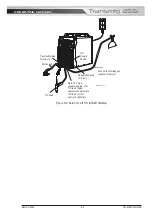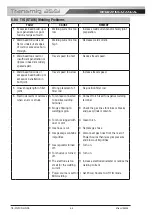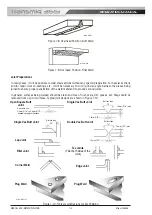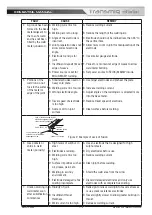
OPERATING MANUAL
MANUAL ARC (MMAW) WELDING
7-2
Manual 0-5586
7.02 Stick (MMAW) Basic Welding Technique
Size of Electrode
The electrode size is determined by the thickness of metals being joined and can also be governed by the type
of welding machine available. Small welding machines will only provide sufficient current (amperage) to run
the smaller size electrodes.
For thin sections, it is necessary to use smaller electrodes otherwise the arc may burn holes through the job.
A little practice will soon establish the most suitable electrode for a given application.
Storage of Electrodes
Always store electrodes in a dry place and in their original containers.
Electrode Polarity
Electrodes are generally connected to the ELECTRODE HOLDER with the Electrode Holder connected positive
polarity. The WORK LEAD is connected negative polarity and is connected to the work piece. If in doubt consult
the electrode data sheet or your nearest Accredited CIGWELD Distributor.
Effects of Arc Welding Various Materials
A. High tensile and alloy steels
The two most prominent effects of welding these steels are the formation of a hardened zone in the weld
area, and, if suitable precautions are not taken, the occurrence in this zone of under-bead cracks may result.
Hardened zone and under-bead cracks in the weld area may be reduced by using the correct electrodes,
preheating, using higher current settings, using larger electrodes sizes, short runs for larger electrode
deposits or tempering in a furnace.
Hydrogen controlled Electrodes must be used for this application. Use Ferrocraft 61 or 16TXP for normal
strength (500 MPa) steels, and Alloycraft range for higher strength steels.
B. Austenitic manganese steels
The effect on manganese steel of slow cooling from high temperatures is to embrittle it. For this reason
it is absolutely essential to keep manganese steel cool during welding by quenching after each weld or
skip welding to distribute the heat. Suitable Electrode types are Cobalarc Austex or Cobalarc Mangcraft.
C. Cast Iron
Most types of cast iron, except white iron, are weldable. White iron, because of its extreme brittleness,
generally cracks when attempts are made to weld it. Trouble may also be experienced when welding white-
heart malleable, due to the porosity caused by gas held in this type of iron. Suitable Electrode types are
Castcraft 55 or Castcraft 100.
D. Copper and alloys
The most important factor is the high rate of heat conductivity of copper, making preheating of heavy
sections necessary to give proper fusion of weld and base metal. Suitable Electrode types are Bronzecraft
AC-DC electrodes.
Arc Welding Practice
The techniques used for arc welding are almost identical regardless of what types of metals are being joined.
Naturally enough, different types of electrodes would be used for different metals as described in the preceding
section.
Welding Position
The electrodes dealt with in this publication can be used in most positions, i.e. they are suitable for welding in
flat, horizontal, vertical and overhead positions. Numerous applications call for welds to be made in positions
intermediate between these. Some of the common types of welds are shown in Figures 7-2 through 7-9.
Содержание Transmig 355i
Страница 8: ...This Page Intentionally Blank ...
Страница 14: ...OPERATING MANUAL GENERAL INFORMATION 1 6 Manual 0 5586 This Page Intentionally Blank ...
Страница 24: ...OPERATING MANUAL INTRODUCTION 2 10 Manual 0 5586 This Page Intentionally Blank ...
Страница 28: ...OPERATING MANUAL INSTALLATION 3 4 Manual 0 5586 This Page Intentionally Blank ...
Страница 84: ...OPERATING MANUAL TIG GTAW WELDING 6 10 Manual 0 5586 This Page Intentionally Blank ...
Страница 110: ...OPERATING MANUAL KEY SPARE PARTS 9 4 Manual 0 5586 This page intentionally blank ...
Страница 112: ...OPERATING MANUAL APPENDIX A 2 Manual 0 5550 This Page Intentionally Blank ...
Страница 115: ...OPERATING MANUAL Transmig 220i This Page Intentionally Blank ...
















































